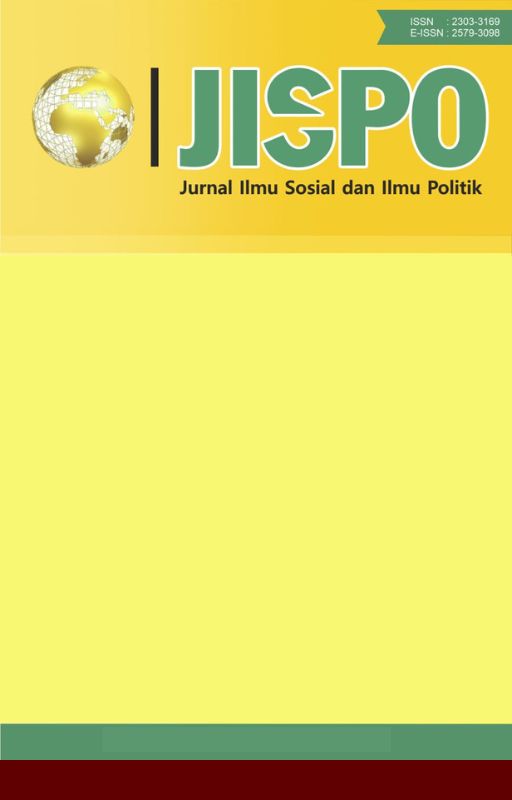PROSES KOMUNIKASI HUMAS POLDA SUMBAR (Studi Deskriptif Humas Yang Objektif, Dipercaya dan Partisipasi)
DOI:
https://doi.org/10.15575/jispo.v9i1.4611Keywords:
Communication, Objective, Trusted, Participation ProcessesAbstract
This study aims to describe and analyze the process of drafting the message, the process of delivering messages, receiving the message itself for the public and finding obstacles and proposing communication in the form of providing information in the West Sumatra Police Public Relations environment. This research was conducted using qualitative methods. Public Relations in other terms also called Public Relations (PR) is the main branch in the study of communication science. Communication skills are the main things that must be developed both academically and in operational activities. In the world of Public Relations (PR) communication is the main expertise that must be owned by a public relations officer, with the communication expected to have similarities between the organization and the public and the formation of favorable public opinion, so that public relations in West Sumatra Police can promote how the process of communication is objective, trusted and participation.
References
Agustinova, D. E. (2015). Memahami Metode Penelitian Kualitatif: Teori dan Praktik. Yogyakarta: Calpulis.
Brown, J., Gaudin, P., & Moran, W. (2013). PR and Communication in Local Government and Public Services (PR In Practice). Kogan Page: Kindle Edition.
Butterick, K. (2012). Pengantar Public Relations: Teori dan Praktik. Jakarta: PT. Raja Grafindo Persada.
Chatra, E., & Dalmenda, M. A. (2016). Etnografi Tata Kelola Humas Pemerintah Daerah. Laporan Penelitian, Tidak Dipublikasikan.
Cangara, H. (2016). Komunikasi Politik: Konsep, Teori, dan Strategi. Jakarta: PT Raja Grafindo Persada.
Cutlip, S. M., Center, A. H., & Broom, G. M. (2011). Effective Public Relations. Jakarta: Kencana Prenada Media Group.
Djusan, A. (2012). Praktik Government Public Relations Paska Otonomi Daerah (Sebuah Tinjauan dengan Kasus Penyuluh KB sebagai Government Public Relations Bidang KB). Jurnal Studi Komunikasi dan Media, 16(1): 61–70.
Doorley, J., & Gracia, H. F. (2007). Reputation Management: The Key to Successful Public Relation and Corporate Communication. New York: Routledge.
Jaques, T. (2014). Issue and Crisis Management: Exploring Issues, Crises, Risk and Reputation. OUP Australia & New Zealand: Kindle Edition.
Jefkins, F. (2004). Public Relations. Jakarta: Erlangga.
Graham, M., & Avery, E. J. (2013). Government Public Relations and Social Media: An Analysis of the Perceptions and Trends of Social Media Use at the Local Government Level. Public Relations Journal, 7(4): 1-21.
Griffin, A. (2008). New Strategies for Reputation Management: Gaining Control of Issues, Crises, & Corporate Social Responsibility. London: Kogan Page.
Hamidi. (2005). Metode Penelitian Kualitatif: Aplikasi Praktis Pembuatan Proposal dan Laporan Penelitian. Malang: UMM PRESS.
Kriyantono, R. (2007). Teknik Praktis Riset Komunikasi. Jakarta: Kencana Prenada Media Group.
Kriyantono, R. (2014). Teori Public Relations Perspektif Barat dan Lokal: Aplikasi Penelitian dan Praktik. Jakarta: Kencana Prenada Media Group.
Komarudin. (2014). Reformasi Humas Pemerintah. Jakarta: Genesindo.
Moloeng, L. J. (2014). Metodologi Penelitian Kualitatif. Bandung: PT. Remaja
Prayudi. (2007). Manajemen Isu dan Tantangan Masa Depan: Pendekatan Public Relations. Jurnal Ilmu Komunikasi, 4(1): 25 – 39.
Putra, I. G. N. (1999). Tantangan Public Relations dalam Sektor Publik: Sebuah Catatan Awal. JKAP, 3(1): 62-72.
Rakhmat, J. (1998). Metode Penelitian Komunikasi. Bandung: PT. Remaja Rosdakarya.
Ridwan. (2010). Metode dan Teknik Menyusun Tesis. Bandung: Alfabeta.
Ruslan, R. (2014). Manajemen Pubic Relations & Media Komunikasi: Konsepsi dan Aplikasi. Jakarta: PT. Raja Grafindo Persada.
Sanders, K., & Canel, M. J. (2013). Government Communication: Cases and Challenges. Bloomsbury Publishing: Kindle Edition.
Soemirat, S., & Ardianto, E. (2010). Dasar-Dasar Public Relations. BandungL PT Remaja Rosdakarya.
Sugiyono. (2014). Metode Penelitian Kuantitatif, Kualitatif, dan R&D. Bandung: Alfabeta.
Downloads
Published
How to Cite
Issue
Section
License
Authors who publish their manuscripts in JISPO agree to the following terms:
- Authors retain copyright and grant the journal right of first publication with the work simultaneously licensed under a Creative Commons Attribution-ShareAlike 4.0 International License that allows others to share the work with an acknowledgment of the work's authorship and initial publication in this journal;
- Authors are able to enter into separate, additional contractual arrangements for the non-exclusive distribution of the journal's published version of the work (e.g., post it to an institutional repository or publish it in a book), with an acknowledgment of its initial publication in this journal; and
- Authors are permitted and encouraged to post their work online (e.g., in institutional repositories or on their websites) after publication process, or prior to and during the submission process, as it can lead to productive exchanges, as well as earlier and greater citation of published work (See The Effect of Open Access).


